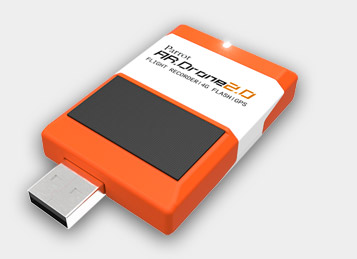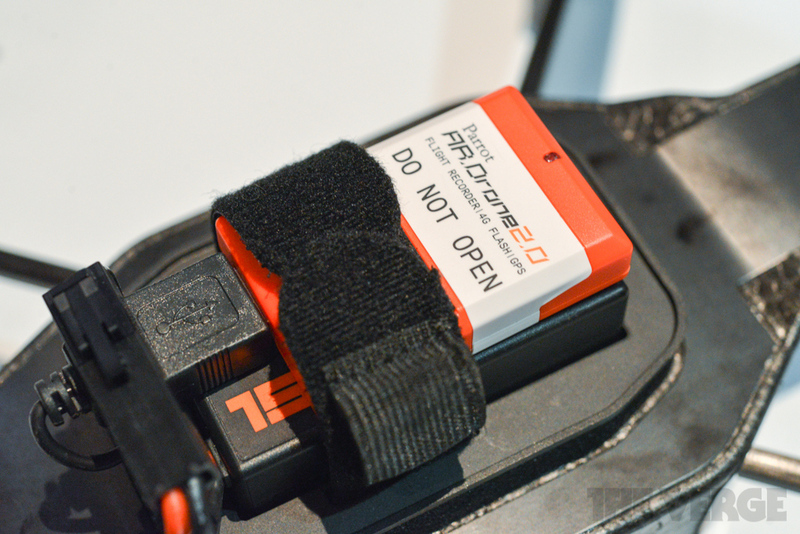The quadcopter AR.Drone — announced standard GPS receiver. Finally!
 Beginning with the launch of quadrocopter AR.Drone 2.0 from Parrot owners suffered from lack of a GPS receiver, which deprived the drone of the ability to know your location as well as did not allow to realize the function as the automatic return to the launch site. Of course, modelers and enthusiasts did not sit idly by, and found ways to connect custom GPS modules to the AR.Drone 2.0 via onboard USB. It required some dancing with firmware drivers. But this year, the manufacturer of AR.Drone — Parrot has announced a standard GPS receiver called the Flight Recorder.
Beginning with the launch of quadrocopter AR.Drone 2.0 from Parrot owners suffered from lack of a GPS receiver, which deprived the drone of the ability to know your location as well as did not allow to realize the function as the automatic return to the launch site. Of course, modelers and enthusiasts did not sit idly by, and found ways to connect custom GPS modules to the AR.Drone 2.0 via onboard USB. It required some dancing with firmware drivers. But this year, the manufacturer of AR.Drone — Parrot has announced a standard GPS receiver called the Flight Recorder. It's connected to the drone device, which has 4Gb of memory, GPS receiver, and adds the possibility of flight on the route, and more.
Hitherto, in order to connect to the AR.Drone GPS were required to engage in the firmware USB drivers drone and / or to connect it to Arduino invading the delicate inner world of the drone that was the lot of desperate enthusiasts. Reflection on the popularity of such mods Parrot apparently decided that this is a useful feature and announced the release of their own devices to navigate. It is obvious that to produce AR.Drone 3.0 (or 2.0 s? And now it's fashionable...) for this function is unlikely, they decided to release the device in the form of a plug-in. Fortunately, on Board the drone has a USB port. Initially the USB port was designed exclusively for connecting external USB drives to write them a video of the flight. Now USB is used to connect to the GPS module. In this case, the module contains a 4Gb USB flash drive, so that solves both problems at once — GPS navigation and external flash drive. And, judging by the description, the module contains a USB input socket that allows you to insert another flash drive, if someone does not have enough available 4Gb. Mounted in the drone module was shown at the last CES 2013 and is as follows. Following the tradition of aviation black boxes, it has a bright orange color.

Using GPS, flight data transmitted in AR.Drone Academy will include the coordinates, so the flight path will be displayed in 3-dimensional form.
What is interesting is that the Parrot never said that he was going to implement the function return the drone to the take-off location in their applications.
Nice addition of the module is that it is compatible with the Protocol MAVLink and as a result can integrate with opensorce systems such as QGroundControl. And it gives the option of using applications under Windows/Linux/Mac OS to create routes for flying drone in Autonomous mode. So now you can easily scare the neighbors or launch drones to patrol the area (already thinking how it can be used in airsoft). So, apparently, we can expect the updates AR.Drone API to programmatically work with the module.
A slight concern I personally have is the fact that, the module looks quite thick. Coupled with the fact that the regular battery is only 12 minutes (according to his passport, in fact about 8), AR.Drone is often used the extended battery capacity 2300mAh (instead of the regular ones at 1000mAh), which is itself too thick. Therefore, as will be a new module if you use the extended battery — a question. Will close if staff cover when it is not yet clear, may need to increase the size of the cavity with the cutting tool.
The new module is compatible only with AR.Drone 2.0 because the first version of Drona no USB. Unit price and timing of release is still unknown as the detailed specification of the device. But on the official website, you can subscribe to a notification about the availability of the module for the order.
And to finish, a video from official website:
Комментарии
Отправить комментарий